CRM vs. CMS: Which is Right for Your Business?
CRM and CMS may sound pretty similar, but they’re two distinct types of software that do completely different things. Successful businesses, however, often use both. But the first step is learning the differences between CRM and CMS software.
This post will be your guide to navigating the world of CRM and CMS software. By the end, you’ll feel confident making your next software purchase—whether it be a CRM, CMS, or both!
Your Guide For Choosing a CRM or CMS
Before diving into what to consider when investing in a new CRM or CMS platform, here’s a quick primer on each:
CRM Systems: Large contact database that helps businesses store and track contact and account records. Users can add new business leads into the database and augment existing contact records with new information. Customer-facing teams like sales, marketing, and customer service/support rely on this type of software.
CMS Software: Create and update content published on websites. The CMS is responsible for storing and keeping track of all the content published on the website. Many businesses use a CMS platform to host their website or blog. This is especially common in B2C industries like eCommerce. Though many B2B businesses use CMS platforms for hosting websites or blogs. TrustRadius uses WordPress to host the blog article you’re reading right now.
Some CRM products are designed with sales end-users in mind. Others may be a great option for teams on a tight budget, but not for enterprise sales and marketing teams. Certain CMS tools are more user-friendly for individuals that don’t have a technical background or experience coding. Other CMS platforms provide advanced functionality but require coding knowledge to operate.
Some helpful questions to ask yourself about each product you’re considering:
- Is this product within my budget?
- Does it have all the features my team needs?
- How user-friendly is it? Can my team do a free trial of the software first?
- Will the software integrate with the other sales and marketing software my business already uses?
- Will I need to customize the software? Or can I use it out-of-the-box?
Hands down, testing out the software yourself is one of the best ways to see if it will meet your needs. In our recent research, TrustRadius found that 2 out of 5 buyers use free trials to help them make a purchase decision. Many vendors offer 14 to 30-day free trials or a free version of their software. Before pulling the trigger on a new CRM or CMS system, make sure to get some hands-on experience with the product.
What is a CRM?
At a basic level, CRM software is a giant database used to house and keep track of contact information. But modern CRM systems can do so much more than simply store data.
Sales and marketing teams use CRM systems to help track where certain leads or prospects are in the buyer journey. For sales reps, CRMs help them keep track of each interaction (e.g. emails, phone calls, video calls, etc.) they’ve had with a potential customer. This helps track how far along deals are in the sales cycle.
Sales managers and leaders use CRM systems to keep track of sales opportunities and do sales forecasting. They can also make predictions about future revenue using CRM software. Workflow automation tools help individuals automate various sales and marketing tasks. This includes sending sales reminders about lead follow-up. Workflow tools help set up automatic syncs and augmentation of contact records.
Though CRM software is a workhorse piece of sales tech, other departments rely on it too. Marketers continuously collect detailed information about prospects and customers. Rather than be lost in a technology black hole, this information can be synced with the user’s CRM and recorded. This helps highlight another key use case of CRM software: being the single source of truth for all contact data. Most CRM platforms integrate with a wide array of third-party systems that record or produce contact data.
Overall, CRM systems help businesses accelerate the whole sales cycle. Because of the vital role it plays in the sales process, CRM software is considered a core sales acceleration technology. To learn more about how to leverage CRM software, watch this video:
Key CRM Features
There are some CRM features businesses just can’t live without. Others may be overkill, depending on your budget, business size, use case, and the number of users. But a free CRM with limited features likely won’t cut it for enterprise organizations.
Below is a chart that shows standard and more advanced CRM features. Make a mental note of which ones are critical for your use case as you read through the table.
| Feature | Standard | Advanced |
| Contact database | ||
| Sales force automation | ||
| Lead & deal management | ||
| Opportunity management | ||
| Workflow automation | ||
| Custom data fields/objects | ||
| Reporting & Analytics | ||
| Customizable dashboards | ||
| Task Management | ||
| Sales Forecasting | ||
| Integrations with third-party software | ||
| Mobile applications | ||
| Landing page builder | ||
| Email marketing tools | ||
| Marketing automation capabilities | ||
| Project management features |
CRM Pricing
If you’ve decided to invest in a CRM system, the next thing to consider is which platform will give you the biggest bang for your buck. There is no shortage of products to choose from—there are over 200 CRM options listed on TrustRadius! One of the best ways to narrow down the list of products you’re considering is to see which ones fit your budget and feature requirements.
Most CRM platforms charge per user per month and have either monthly or annual billing options. Users typically get a discount with annual billing, though it means you’ll have to stick with the software for at least a year. Certain products like Pipedrive and Salesforce offer 14-day to 30-day free trials of the platform. Others like Zoho CRM and HubSpot have a free CRM product, though with limited functionality.
For some businesses, a free CRM platform may fit their needs perfectly. This is especially true if you’re running a one-person shop, a small business, or are looking to try out a product before upgrading to the paid version. With either HubSpot’s or Zoho CRM’s free plan users have access to features like:
- Contact management
- Deals
- Tasks & activities
- Email integration
- Email notifications
- Standard reporting
- CRM dashboards
- Workflow rules
Free plans are often limited. For example, the free version of Zoho CRM only allows up to 3 users and caps email notifications at 150 per day. Hubspot’s free CRM is limited to 200 email notifications per month and 5 email templates.
If you’re looking for a CRM platform with a wider range of features, the lowest tier plans typically cost between $12-$25/user/mo. Mid-tier plans can range from $30/user/mo. with enterprise-level plans ranging from $100/user/mo. up to multiple hundreds of dollars per user per month.
3 CRM Products To Consider
No two businesses are exactly alike or have the same use case. This is especially important to consider when purchasing a CRM platform. Here are 3 popular CRM products that are each well-suited for a different type of user.
Pipedrive
Pipedrive is well known for being a sales-focused CRM. It’s been designed with sales reps, managers, and leaders in mind. Users have access to sales-specific features like customizable pipelines and sales dialing. Pipedrive also includes the ability to track sales quotes and proposal docs. E-signature capabilities help sales reps save time as well.
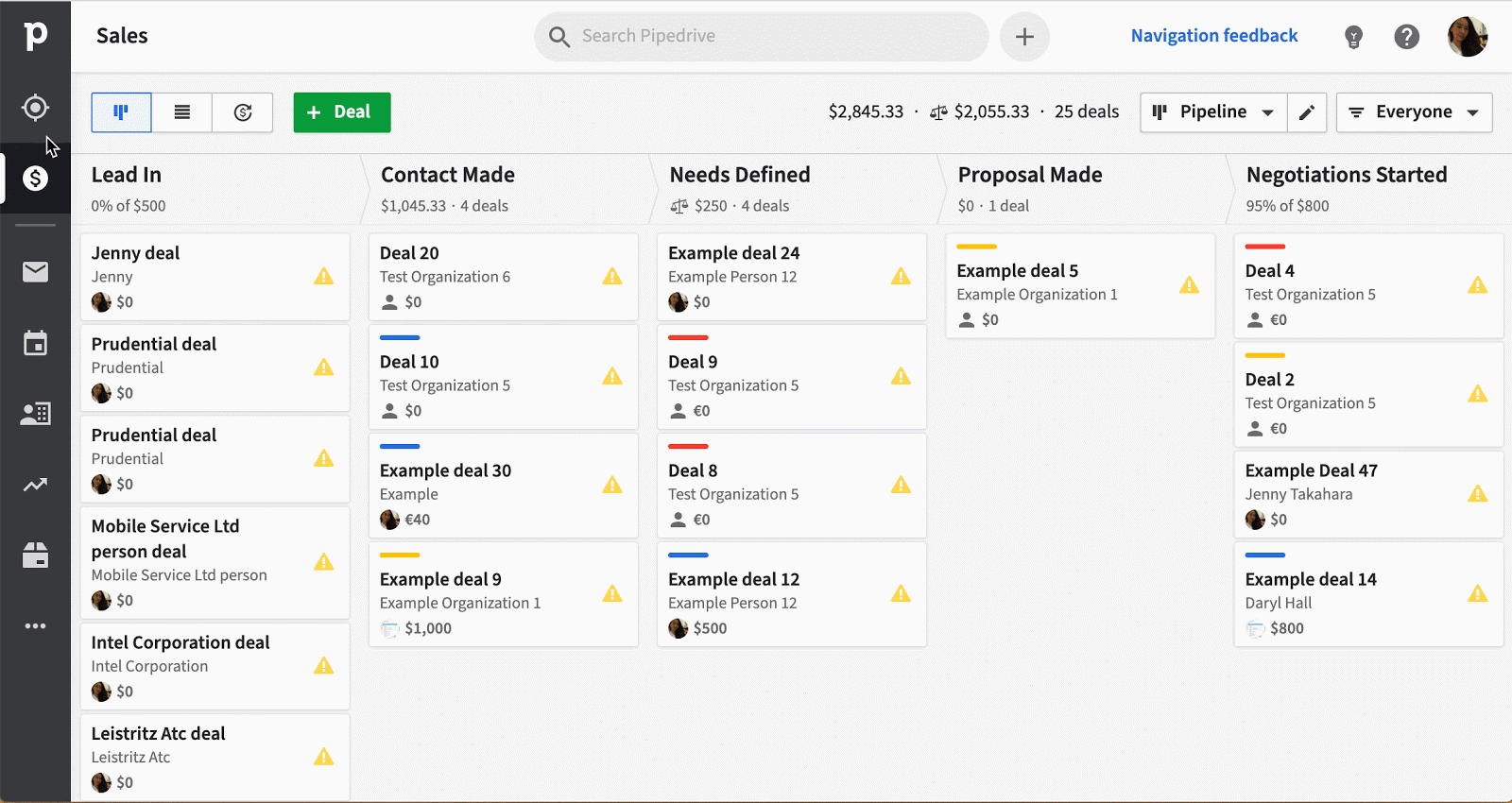
Source: https://www.trustradius.com/products/hubspot-crm/reviews
According to Pipedrive reviewers on TrustRadius, some of the most common pros of the software include:
- Managing new leads
- Customizable pipeline
- Automation for repetitive tasks
- Sales activity tracking
Users also mention that the platform is very cost-effective. Overall, this makes it a great choice for a small or growing sales team. However, Pipedrive may not be the best fit for larger teams that require advanced features. Though for this sales director, Pipedrive was the perfect fit for his business:
“Pipedrive is less complex and far more affordable. It is missing some of the marketing tools (email marketing, adspend tracking, etc.) But for a small team this tool is far superior. It cuts out the fluff and focuses on helping you manage a pipeline. And the cost is a million times better!”
Mark Rueckert | Sales Director | Elemerce Marketing & Advertising Company (51-200 employees)
Salesforce
Salesforce is one of the most well-known and popular CRM platforms. It is truly a best-of-breed solution and will work well for businesses that are using other Salesforce products. Even though it’s a giant in the CRM world, Salesforce also has affordable plans for small and midsize businesses. Its lowest-priced tier starts at just $25/user/mo. Salesforce has embedded their CRM solution in their larger Sales Cloud solution. (Many other CRMs are stand-alone products.)
More advanced users and businesses looking to scale up their sales teams have more functionality at their fingertips. Rules-based lead scoring and lead registration help boost sales rep productivity. Sales leaders reply on Salesforce’s enterprise sales territory management and advanced reporting capabilities. Access to a sandbox environment allows developers to test out changes without impacting the live environment.
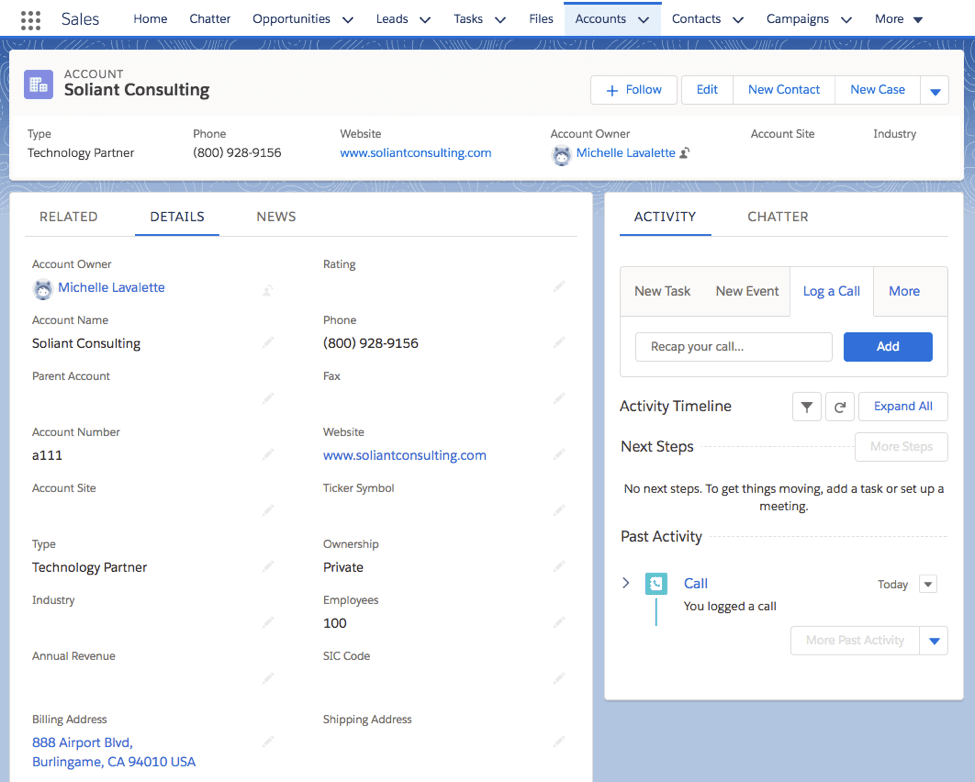
Source: https://www.soliantconsulting.com/blog/salesforce-ui-updates/
Salesforce CRM users on TrustRadius highlight the following key pros of the platform:
- The flexibility and customization of the system
- Interactive reports and dashboards
- Integrations with Salesforce products and other third-party products
All of this makes Salesforce CRM an ideal choice for businesses that need a true industry-leading solution. It’s also a great choice for small and midsize teams that are planning to scale-up quickly, or that need access to advanced features.
One drawback of using Salesforce is that the system will need to be configured and customized for your team to get the most out of it. There are people who base their careers around working with Salesforce. Salesforce is not ideal for users that want to get up and running with a new CRM fast. It requires extensive setup and configuration. This operations manager aptly describes what this meant for his business:
“The biggest advantage with Salesforce is likely the biggest detractor as well. It is largely a blank slate. The system is not customized to any one business or industry out of the box. You have to design everything – which is great if you are looking for a highly customized system, but very difficult for small or even medium sized firms without help from a 3rd party.”
Jeff Fralick | Operations Manager | RESOLUT RE | Commercial Real Estate Company (51-200 employees)
Hubspot CRM
HubSpot’s CRM is one of the best options available for small business owners and small teams. The main reason—it’s free, forever. Not only is it free, but it gives users access to core CRM capabilities. Contact management, company records, and deals information are critical sales enablement features. Email tracking, notifications, and task and activity tracking are productivity-boosting tools.
Small businesses can also take advantage of HubSpot’s free marketing and sales tools, which include:
- Forms
- Email marketing
- Landing page builder
- Ad management
- Live chat
- Chatbots
- Calling from within the platform
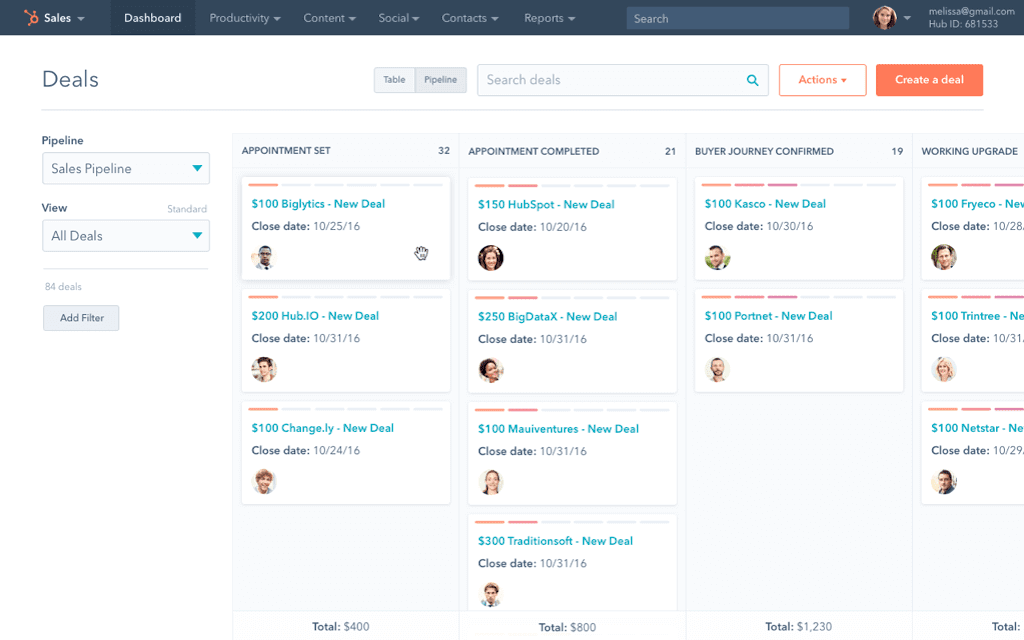
Source: https://www.softwareadvice.com/crm/hubspot-profile/
HubSpot also offers paid plans that include more advanced CRM features. But similarly to Salesforce, its paid CRM platform is embedded in a larger Sales Hub. If you’re looking for a fully-featured CRM with additional sales tools, HubSpot Sales Hub may be a good choice. But users pay a premium for its more expensive plans. HubSpot’s mid-tier Sales Hub plan costs $90/user/mo. and its enterprise plan costs $120/user/mo.
Overall, HubSpot’s free CRM tier is a great choice for freelancers that need to keep track of clients. It’s also great for small businesses that don’t need a bunch of bells and whistles that will cost them extra.
HubSpot CRM reviewers on TrustRadius highlight the following key strengths of the platform:
- Simple to use and clean-looking user interface
- Email tracking capabilities
- Ability to view detailed and high-level lead information
HubSpot CRM’s free version has everything this Co-founded needed to get his B2B SaaS startup off the ground:
“HubSpot CRM is incredible for young startups that are just getting started as it’s free and has a lot of features that come with it. Has everything you’d expect from a free CRM and is the best free CRM for getting started as you figure out what needs you have in your processes that I’ve seen.”
Brad Henderson | Co-Founder/Chief Janitor | Crisp |Computer Software Company (1-10 employees)
What is a CMS?
Content management systems (CMS) are primarily used to create, manage, and deploy website content. They typically include a content authoring and editing interface with a “what you see is what you get” (WYSIWYG) content editor. This helps make the software user-friendly for marketers and other users that don’t have experience coding.
CMS platforms can be used to publish content on various types of websites and applications. These include:
- Websites
- Blogs
- News Websites
- eCommerce Sites
- Intranets
Along with a WYSIWYG editor, CMSs typically include a library of themes, content templates, and content storage. They also offer publishing workflows and the ability to schedule content publishing. These are the core capabilities of traditional CMS software. But other types of CMS platforms offer a more diverse range of features and functionality.
Hybrid and headless CMS platforms operate differently from traditional CMS platforms. More traditional platforms include products like WordPress and MS SharePoint. Traditional or monolithic CMS software has a tightly coupled frontend and backend. Thus the content authoring interface and content database are linked to the frontend content presentation layer (e.g. a blog).
In comparison, hybrid CMS and headless CMS platforms have a decoupled front and backend. You can think of this as the frontend presentation layer—the head—being severed from the backend—the body—of the content management system. These platforms are not attached to one specific presentation layer. Rather, APIs push the content out to applications across multiple channels. Hybrid platforms are special in that they allow businesses to use the CMS software as either a traditional or headless system. These types of CMS platforms can be thought of as the next generation of more traditional platforms.
To learn more about the different types of CMS platforms, watch this video:
Key CMS Features
Before deciding to invest in a new CMS platform, figure out which type of product will work best for your business. Are you looking for a platform that will be user-friendly for non-technical users? Or one that’s attached to a specific presentation layer? If so, a more traditional CMS platform is likely the right choice.
Hybrid or headless will be a better fit if you need to produce content and publish it across digital channels and device types. Though keep in mind, these options will require more developer resources to set up and run.
Here’s a chart that will walk you through which CMS features are associated with traditional platforms vs. headless platforms.
| Feature | Traditional | Headless |
| Website hosting | ||
| WYSIWYG editor | ||
| Page/content templates | ||
| Library of themes | ||
| Content versioning | ||
| Publishing workflow | ||
| Content scheduling | ||
| Content repository/database | ||
| Content tagging tools | ||
| User roles & permissions | ||
| Localization | ||
| Content modeling | ||
| Content APIs | ||
| Omnichannel content publishing |
CMS Pricing
Pricing for CMS platforms can vary widely, depending on what you’re looking for. There are three main groups of CMS platforms that each have different price ranges:
- Open-source CMS software
- B2C and web building CMS software
- Enterprise and B2B CMS software
Open-source CMS platforms like Drupal and Joomla are, of course, free. Benefits of open-source CMS platforms include being highly customizable and being free forever. They require more developer resources to build out and maintain than paid CMS platforms. So make sure you have developers that can customize and build out your CMS platform if you choose to go the open-source route.
Consumer business-focused CMS platforms start at fairly reasonable rates. For example, the website building and CMS platform Wix offers a personal plan for $14/mo. WordPress (one of the most popular blogging platforms) offers a free version of their software. The WordPress personal plan starts at just $4/mo. These types of CMS products can also be used by B2B businesses. Though they might not have advanced features that enterprise B2B organizations need.
CMS software built for enterprise businesses and the B2B industry costs at least a few hundred or thousand dollars per month. Thus they are by far the most expensive group of CMS platforms. Products like Crownpeak DXM, Sitecore Experience Manager and Adobe Experience Manager fall into this group. These are the most expensive type of CMS platform. Thus, they are not well suited for freelancers and small businesses.
3 CMS Products To Consider
There are multiple different types of CMS platforms with a range of price points. Before deciding to purchase a product, consider how well the different types of CMS platforms will fit your use case and budget.
Here are three products that each serve a different type of use case:
WordPress
WordPress is one of the most popular and ubiquitous traditional CMS platforms. TrustRadius uses WordPress to host our software buyer and B2B connection blogs. If you’re looking for a quick and easy way to start a business website, there are a few big advantages of using WordPress. For starters, it offers a free plan that includes website building and hosting tools. All users (even free ones) get a free subdomain when they build a website on the platform. It also has a very user-friendly user interface, with a drag-and-drop website builder and content editor.
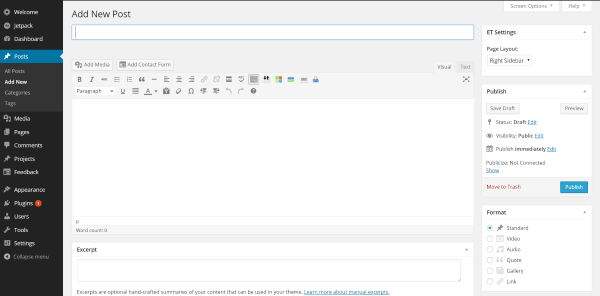
WordPress is a great fit for users that need a few extra features but don’t want to break the bank. It offers a personal plan for a shockingly low $4 a month. Along with all of WordPress’s built-in features, there is a universe of WordPress plugins available. Using plugins, users can enhance and optimize their website in several ways. For example, connecting their website to pageant gateway systems to turn their site into an online store. Other plugins allow users to optimize their website for SEO and view content performance analytics.
All of these features make WordPress a great choice for bloggers, and freelancers. Combining WordPress with eCommerce plugins is perfect for getting your online business off the ground.
According to WordPress reviewers on TrustRadius, some of the top pros of the platform are:
- Wide range of customizable themes to choose from
- Easy to use interface and content editor
- Plugins like Yoast SEO
- Ease of creating professional-looking websites
WordPress’s wide range of free and paid features make it the perfect solution for this small business account manager:
“It is originally intended for blogs, but you don’t need to run a blog to use it. We use it just for regular websites and find it to be excellent. Especially if you have other people that need to add content or make adjustments, you can assign them logins and roles to add content, edit, make changes, etc. There are so many free and paid themes that allow you to do just about anything, I can’t really think of an instance where WordPress would not be an appropriate option for a website.”
Verified User | Account Manager in Other | E-Learning Company (1-10 employees)
Crownpeak DXM
Crownpeak DXM is an enterprise-grade CMS platform. Importantly, it’s a hybrid platform that can be leveraged either as a more traditional CMS or a headless content management system. This makes it well-suited for both B2B and B2C companies. It’s also great for businesses that publish digital content across a variety of channels and applications. As a true enterprise solution, Crownpeak DXM will likely take new users longer to come up to speed and become familiar with the platform.
As a hybrid platform, it offers users advanced features such as:
- custom content modeling
- publishing to multiple websites at once
- content A/B testing
- targeting rules
- content localization
- translation tools.
This makes the platform more expensive than options like WordPress, Wix, or Squarespace.
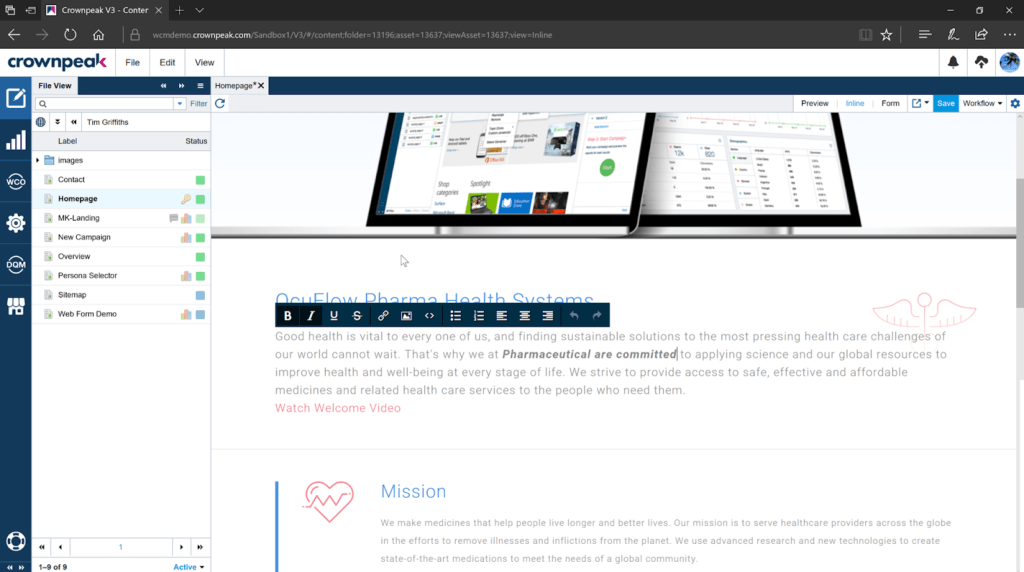
Source: https://bit.ly/3lTcjxH
Based on reviewer feedback on TrustRadius, some of the most common Crownpeak DXM pros are:
- Fast turnaround time for deploying new content or experiences
- The scalability of the platform
- Integrations and content APIs
- Platform security
Crownpeak DXM is a great option for enterprise B2B and B2C companies. It helps create and manage their digital content and experiences across a range of channels. Crownpeak is a go-to choice for this business partner development manager:
“Crownpeak DXM is well suited for companies who need to efficiently push content out across multiple channels with minimal fuss. It is a great choice for enterprise-level businesses that need an agile and comprehensive content workflow as it is cloud-based, agile, and offers automatic system upgrades. It fits seamlessly into a customer technology ecosystem as it is highly interoperable, and integrates well with industry leaders in the DAM, PIM, and TMS spaces.”
Lauren Johnston | Partner Development Manager | XTM International | Computer Software Company (51-200 employees)
MS SharePoint
Microsoft (MS) SharePoint is best suited for a slightly different use case than CMS platforms like WordPress or Crownpeak DXM. Instead, it’s a popular choice for organizations looking to set up an intranet—i.e. an internal website that acts as an employee knowledge-base. It offers users seamless integrations with other Microsoft products (e.g. Microsoft Office, Teams, etc.).
It is frequently used for document storage, collaborative editing, and creating web applications. It’s also easy to set up different user access permissions and specific approval workflows. One of the most common MS SHarePoint use cases is to create and maintain knowledge bases. But it can also be used to create public-facing websites.
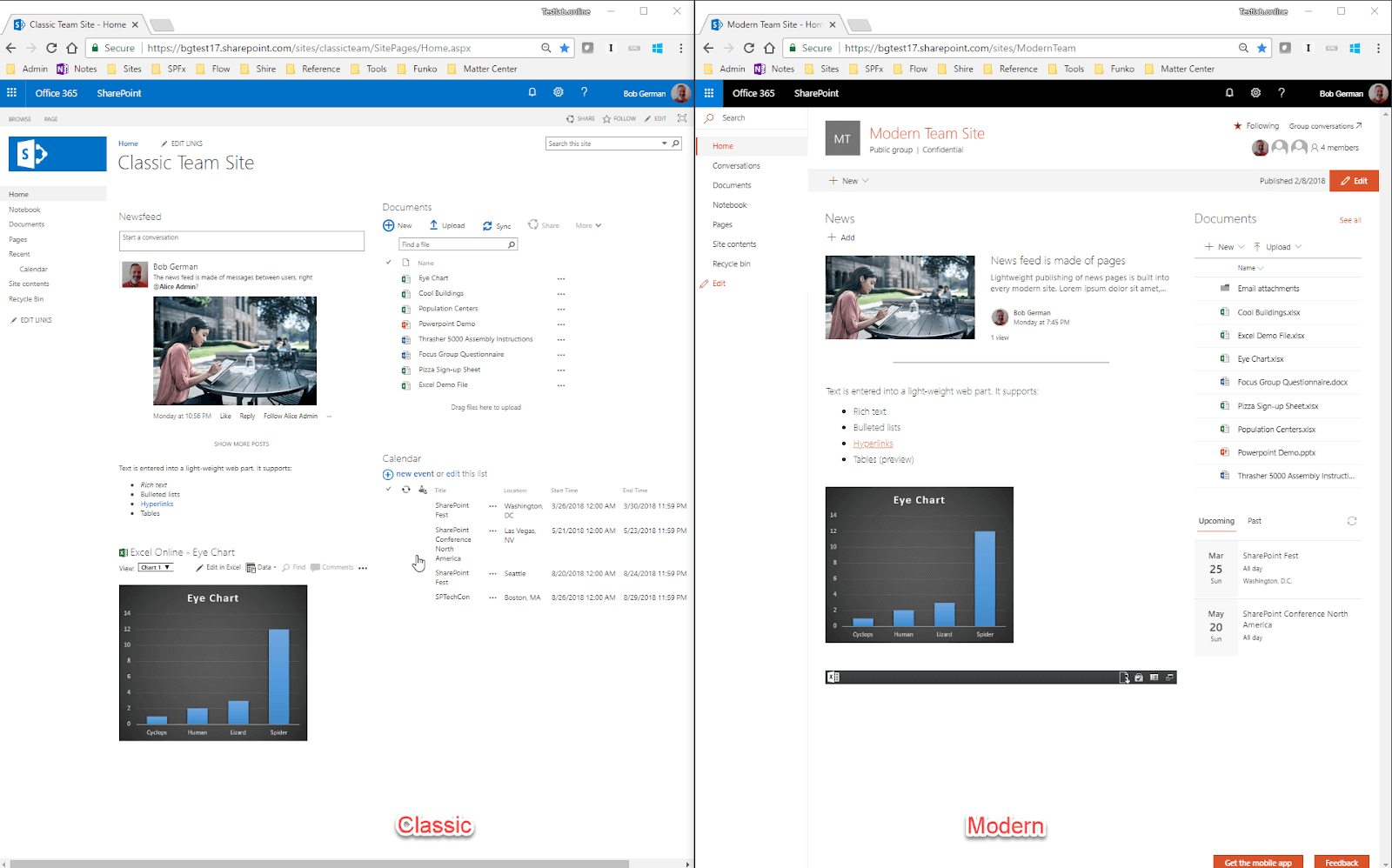
Reviewers of MS Sharepoint on TrustRadius highlight the following as key strengths of the platform:
- Collaborative document editing
- Integration with Microsoft Teams and Microsoft Office 365 products
- Ability to set up granular user-permissions
In summary, MS Sharepoint is ideal for businesses looking for a CMS that will help them create an internal knowledge base. MS SharePoint makes it easy for users to add to, collaborate on, and easily navigate intranets. This customer service administrator’s company has leveraged MS SharePoint as an internal hub:
“SharePoint has been incredibly helpful especially during the pandemic. We are able to easily have a hub that has access to everything our teams need. It is very easy to organize and fun to use. It is a lot easier than sharing each individual document with everyone that should have access. Rather you can choose the groups that have access to what and upload.”
Verified User | Administrator in Customer Service | Education Management Company (11-50 employees)
More CRM and CMS Resources
If you’re still debating whether a CRM or CMS is right for you, use the resources below to help narrow down your choice. Or maybe you’re got that far but are now wondering which specific product will work best for your team. Either way, the following steps will help you get you closer to a final decision:
Was this helpful?
